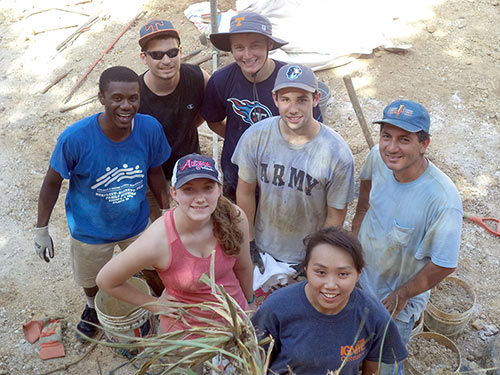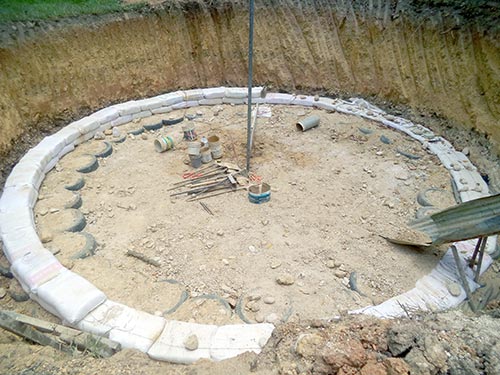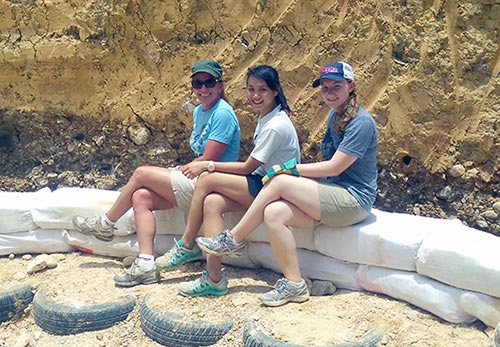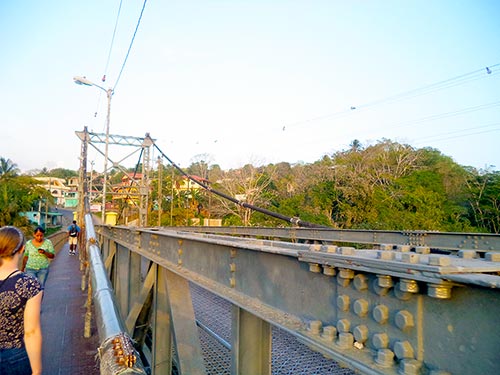Trip Report: Alternative Summer Break in Belize

- Read Rosemary Dabbs’ report on the Belize trip »
- Read Alex Grim’s report on the Belize trip »
- Read Andre Norfleet’s report on the Belize trip »
- Read Andrew Turner’s report on the Belize trip »
- Read Joe Willenborg’s report on the Belize trip »
- Read Maggie Lau’s report on the Belize trip »
The TCE Alternative Summer Break for 2015 took place in San Ignacio, Belize, from May 11–17. Six TCE students accompanied TCE International Coordinator Judith Mallory on the trip. They are: chemical engineers Rosemary Dabbs and Maggie Lau; mechanical engineer Alex Grim; electrical engineer Andrew Turner; biomedical engineer Andre’ Norfleet; and the first nuclear engineer to travel with Global Initiatives, Joe Willenborg. Kaya Responsible Travel served as the trip provider.
Formerly known as British Honduras, a Crown Colony, Belize gained independence in 1981 and was renamed. The only country in Central America with English as its official language has three major ethnic groups: Maya descendants, Black Africans, and Mestizos, descendants of Spanish immigrants. Languages spoken are English, Spanish, Kriol (from an African dialect) and the indigenous dialects, including K’iche’. Interestingly, Belizeans more strongly identify as Caribbean rather than as Central American.
Upon landing, the group was collected by their host, Jaime Morin, who with his wife, Nancy, served as in-country coordinators for the week. Jaime toured the group around Belize City prior to heading out to the countryside. The Caribbean Sea comes right up to the edge of the city, which is colonial in style and was once the country’s capital.
The service project with which the group was charged involved the construction of a large root cellar located on a sustainable farm. The farm is envisioned to become a home for girls aging out of the foster care system, and is expected to open in about a year. A small orchard has been planted, and they are already growing vegetables and herbs there. Chickens, rabbits, and goats are already there, as well as geese and guineas. Everything the residents need for food will come from the farm. Several dome-shaped structures are already in place.

The root cellar began as a circular hole, about 14’ deep and 30’ in diameter. It had been excavated by machine the previous week. The group members had to climb down a ladder to work in the hole. The first step involved placing donated used tires into the hole. The tires were placed in a circle, leaving some room between them and the edge of the hole. A large compass was made by inserting a 15’ piece of fence pipe in the center of the hole, in the ground.
Perpendicular to the pole was another pole, attached by a fence pipe coupling, and holding a level. The swing-arm motion provided by the compass allowed perfect placement of the tires. Each tire had to be filled with a sand/rock/dirt mixture and tamped down for stability.
Once two rows of tires were placed side-by-side, it was time for the earth bags. Earth bag construction involves filling bags with whatever material is available (in this case sand/rocks/dirt), fastening the top with a nail, tamping out air pockets, and placing for foundation and walls. The earth bags are suitable for shifts in the earth, for example in an earthquake.
A makeshift chute was made using long pieces of scrap corrugated aluminum. This allowed dirt to be quickly transported from above to the floor of the hole. Dirt traveling down the chute had to first be measured out in order to have the correct amount to mix with lime before the bags were filled. The dry ingredients were mixed together thoroughly, much as one would do when mixing ingredients for a cake.

Piles were made in the hole and water in buckets was lowered using ropes; a small amount of water was added to the mix in order that it would settle correctly in the bags. This operation went on for the four work days. Once one row of bags was placed in the prescribed circular pattern, another row was placed atop the first row. To provide tensile strength, two rolls of barbed wire were unrolled and placed atop the first row of bags and held by rocks until the second row of bags could be placed, and so forth. This also keeps the bags, originally used for seed, from slipping.
This marks the most labor-intensive project so far for Global Initiatives.
Working alongside the group was Jaime, who is a licensed architect, his 12-year-old son Leo, and Hernan, his wife, and their five-year old son. Hernan, an immigrant from Honduras, serves as the caretaker of the farm, called Barzakh Fala.
The finished root cellar will look something like this: Dirt will be brought in to make the floor level with the tires. Earth bags will line the entire interior. Plastic sheeting, similar to a pond liner, will be placed between the bags and the edge of the hole, to keep out moisture. The floor will be concrete and the “walls” will be first lined with chicken wire, and then plastered smooth. A dome house will sit atop the root cellar. Construction is entirely based upon compression, as opposed to traditional post-and-beam construction.
Side activities included a trip to the Green Iguana Conservation Project. Apparently, the population of green iguanas is somewhat compromised (not yet classified as “threatened”) due to people eating them. The project obtains eggs and brings them in to hatch. Iguanas are kept there for several years prior to being introduced into the wild.
The group toured around a thriving Mennonite community in Spanish Lookout. In the 1950s, a group of Mennonites came to Belize from Canada. At that time, eggs had to be imported to Belize, as no one was raising chickens. Today, the Mennonites are the country’s primary producers of dairy, meat, poultry, and produce. In addition, they serve as an employer for a sizeable immigrant community. They maintain their own roads and are known as mechanical geniuses for their ability to work on farm machinery. The largest concentration of millionaires in the country is found in Spanish Lookout.
One of the field trips involved canoeing the Macal River to a picnic area. After the canoe trip, the group toured the local produce and crafts market in town. A notable feature of the town is the Hawkesworth Bridge, which once was in Sierra Leone. The British disassembled it and moved it to San Igancio in 1949, where it stands today as a crossing for pedestrians and cars alike, over the Macal River.
Another field trip was by horseback to the Maya archaeological site of Xunantunich. Between the horse farm and the ruins, the group had to cross the Mopan River, with their horses, via a hand-cranked ferry. The temples and plazas of Xunantunich date to the 7th century.
On the way to the airport in Belize City for the trip home, the group got to visit the Belize Zoo, a 29-acre property providing a home for animals endemic to the region, many of whom were rescued or injured. Animals seen there include the tapir, national animal of Belize, scarlet macaws, storks, coatimundi, peccaries, pumas, ocelots, and black howler monkeys.
